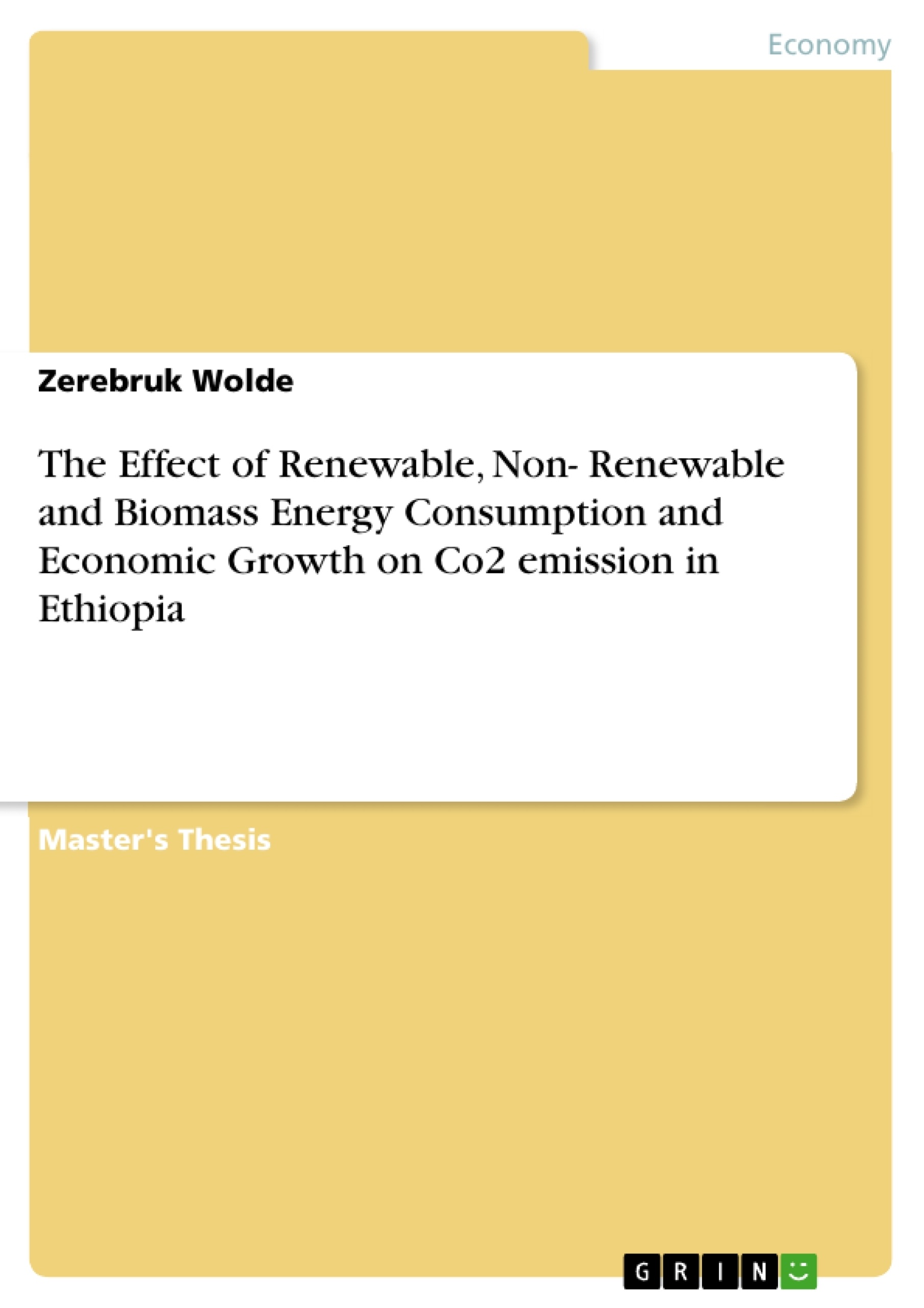
The Effect of Renewable, Non- Renewable and Biomass Energy Consumption and Economic Growth on Co2 emission in Ethiopia
Masterarbeit, 2017
95 Seiten, Note: Very Good
Leseprobe
Table of Contents
- Chapter one: Introduction
- 1.1 Background of the study
- 1.2 Statement of the problem
- 1.3 Data source and type
- 1.4 Significance of the study
- 1.5 Objective of the study
- 1.6 Organization of the paper
- Chapter two: Review of Theoretical and Empirical Literature
- 2.1 Review of Theoretical Literature
- 2.1.1 Introduction
- 2.1.2 Energy, Growth and Environment
- 2.1.3 Renewable energy, Economic Growth and the environment
- 2.2 Empirical review
- 2.2.1 International studies
- 2.2.2 Studies on Ethiopia
- Chapter three: Overview of Energy and Emission in Ethiopia
- 3.1 Ethiopia's Energy sector overview
- 3.2 Overview of Ethiopia's Emission Profile
Objectives and Key Themes
The study aims to examine the impact of biomass, renewable, and non-renewable energy consumption, as well as economic growth, on CO2 emissions in Ethiopia. It utilizes the Autoregressive Distributive Lag (ARDL) method to analyze the relationships between these variables.
- The relationship between different energy sources (biomass, renewable, and non-renewable) and CO2 emissions.
- The impact of economic growth on CO2 emissions in Ethiopia.
- The long-run and short-run effects of energy consumption on CO2 emissions.
- Analysis of Ethiopia's energy sector and emission profile.
- Evaluation of the sustainability of Ethiopia's current energy reliance.
Chapter Summaries
Chapter one: Introduction: This chapter sets the stage for the study by providing background information on the global shift towards renewable energy sources and the need to assess their impact in specific contexts, particularly in developing countries like Ethiopia. It highlights the unsustainable nature of traditional energy sources and introduces the research problem, focusing on the relationship between energy consumption (from various sources) and CO2 emissions in Ethiopia. The chapter outlines the data sources, the significance of the study, its specific objectives, and the organization of the research paper.
Chapter two: Review of Theoretical and Empirical Literature: This chapter delves into existing theoretical and empirical literature relevant to the study’s focus. The theoretical review examines established frameworks connecting energy, economic growth, and environmental impact, specifically highlighting the roles of renewable and non-renewable energy sources. The empirical review analyzes both international and country-specific studies, particularly those focusing on Ethiopia, to provide context and establish a base for the current research. It synthesizes existing findings to identify knowledge gaps and to establish the study’s theoretical foundation.
Chapter three: Overview of Energy and Emission in Ethiopia: This chapter provides a comprehensive overview of Ethiopia’s energy sector and its emission profile. It offers a detailed analysis of the current state of the energy sector, including the types of energy sources utilized, their distribution and utilization patterns, and their overall contribution to the country's energy needs. This section is crucial to contextualize the study's empirical analysis, providing a background against which to evaluate the impact of different energy types on CO2 emissions. The chapter further examines Ethiopia's CO2 emission levels, identifying sources and trends to establish a baseline for evaluating the effects of energy consumption.
Keywords
CO2 emission, Biomass energy, Renewable energy, Non-renewable energy, Economic growth, Autoregressive Distributive Lag (ARDL), Ethiopia, Energy consumption, Environmental impact, Sustainability.
Frequently Asked Questions: A Comprehensive Language Preview
What is the main topic of this study?
This study examines the impact of biomass, renewable, and non-renewable energy consumption, and economic growth on CO2 emissions in Ethiopia. It uses the Autoregressive Distributive Lag (ARDL) method for analysis.
What are the key themes explored in this research?
Key themes include the relationship between different energy sources (biomass, renewable, and non-renewable) and CO2 emissions; the impact of economic growth on CO2 emissions in Ethiopia; the long-run and short-run effects of energy consumption on CO2 emissions; an analysis of Ethiopia's energy sector and emission profile; and an evaluation of the sustainability of Ethiopia's current energy reliance.
What is the structure of the research paper?
The paper is structured into three main chapters. Chapter one provides an introduction, background, problem statement, data sources, significance, objectives, and organization of the paper. Chapter two reviews relevant theoretical and empirical literature, both internationally and specifically on Ethiopia. Chapter three gives an overview of Ethiopia's energy sector and emission profile.
What data and methodology are used?
The study utilizes the Autoregressive Distributive Lag (ARDL) method to analyze the relationships between energy consumption (from various sources), economic growth, and CO2 emissions in Ethiopia. The specific data sources are detailed in Chapter 1.
What are the key findings or objectives of the study (in brief)?
The study aims to understand the complex interplay between various energy sources, economic growth, and CO2 emissions in Ethiopia. It seeks to determine the long-term and short-term effects of different energy consumption patterns on CO2 emissions and assess the sustainability of Ethiopia's current energy practices.
What is the significance of this research?
The research is significant because it provides valuable insights into the energy-emissions relationship in a developing country context. The findings can inform policy decisions related to sustainable energy development and environmental protection in Ethiopia and potentially offer transferable lessons to other similar economies.
What are the keywords associated with this research?
CO2 emission, Biomass energy, Renewable energy, Non-renewable energy, Economic growth, Autoregressive Distributive Lag (ARDL), Ethiopia, Energy consumption, Environmental impact, Sustainability.
Where can I find more detailed information about each chapter?
The provided document includes detailed summaries for each chapter: Chapter one (Introduction), Chapter two (Review of Theoretical and Empirical Literature), and Chapter three (Overview of Energy and Emission in Ethiopia).
Details
- Titel
- The Effect of Renewable, Non- Renewable and Biomass Energy Consumption and Economic Growth on Co2 emission in Ethiopia
- Hochschule
- Addis Ababa University (School of Economics)
- Veranstaltung
- Economics
- Note
- Very Good
- Autor
- Zerebruk Wolde (Autor:in)
- Erscheinungsjahr
- 2017
- Seiten
- 95
- Katalognummer
- V901881
- ISBN (eBook)
- 9783346189547
- ISBN (Buch)
- 9783346189554
- Sprache
- Englisch
- Schlagworte
- biomass consumption economic effect energy ethiopia growth non- renewable
- Produktsicherheit
- GRIN Publishing GmbH
- Preis (Ebook)
- US$ 40,99
- Preis (Book)
- US$ 52,99
- Arbeit zitieren
- Zerebruk Wolde (Autor:in), 2017, The Effect of Renewable, Non- Renewable and Biomass Energy Consumption and Economic Growth on Co2 emission in Ethiopia, München, Page::Imprint:: GRINVerlagOHG, https://www.diplomarbeiten24.de/document/901881
- Autor werden
- Ihre Optionen
- Vertriebskanäle
- Premium Services
- Autorenprofil
- Textarten und Formate
- Services für Verlage, Hochschulen, Unternehmen

- © GRIN Publishing GmbH.
- Alle Inhalte urheberrechtlich geschützt. Kopieren und verbreiten untersagt.
- info@grin.com
- AGB
- Open Publishing
Der GRIN Verlag hat sich seit 1998 auf die Veröffentlichung akademischer eBooks und Bücher spezialisiert. Der GRIN Verlag steht damit als erstes Unternehmen für User Generated Quality Content. Die Verlagsseiten GRIN.com, Hausarbeiten.de und Diplomarbeiten24 bieten für Hochschullehrer, Absolventen und Studenten die ideale Plattform, wissenschaftliche Texte wie Hausarbeiten, Referate, Bachelorarbeiten, Masterarbeiten, Diplomarbeiten, Dissertationen und wissenschaftliche Aufsätze einem breiten Publikum zu präsentieren.
Kostenfreie Veröffentlichung: Hausarbeit, Bachelorarbeit, Diplomarbeit, Dissertation, Masterarbeit, Interpretation oder Referat jetzt veröffentlichen!
- GRIN Verlag GmbH
-
- Nymphenburger Str. 86
- 80636
- Munich, Deutschland
- +49 89-550559-0
- +49 89-550559-10
- info@grin.com
-









